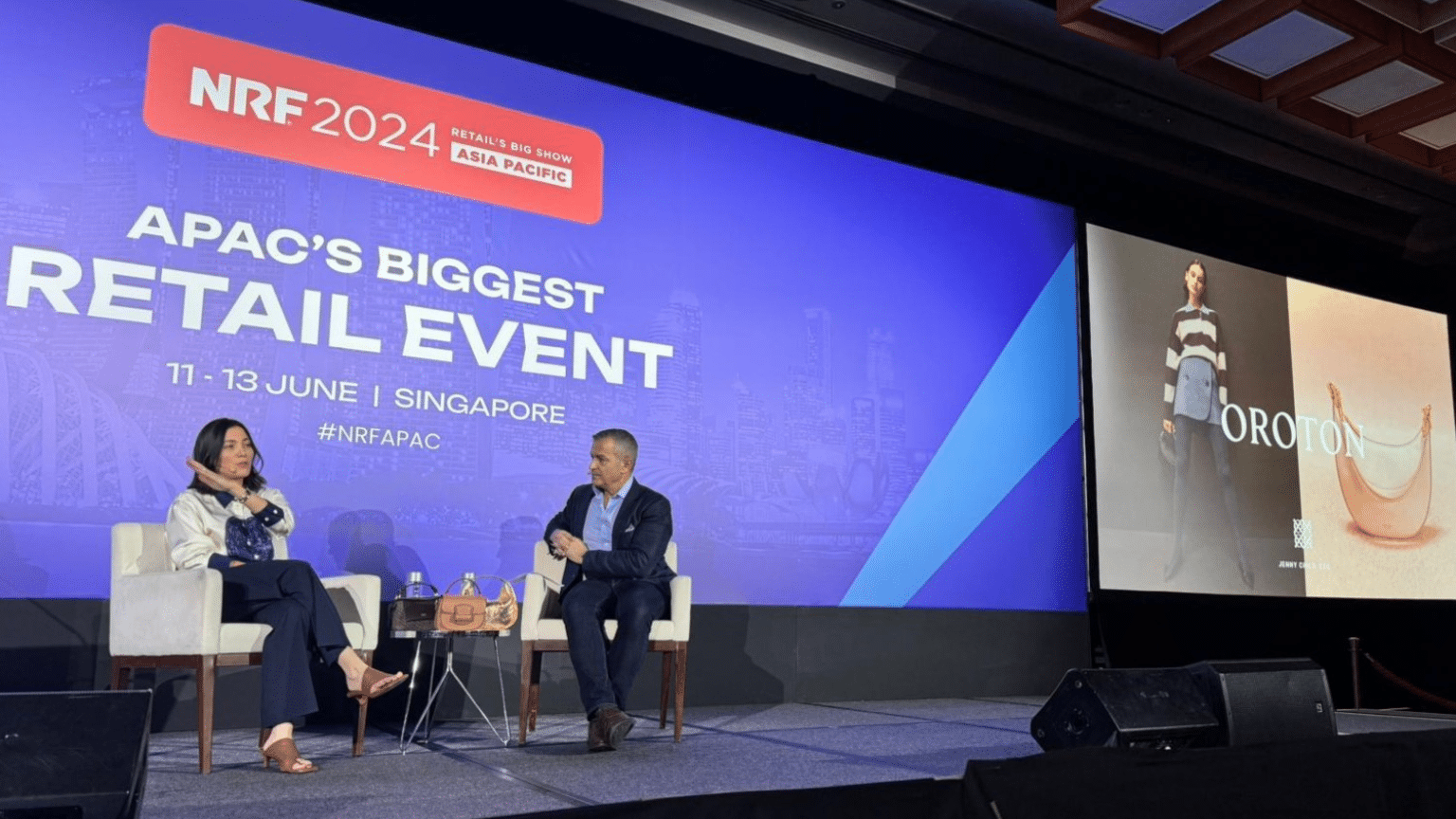This afternoon, we heard from Jennifer Child, CEO of Australian retailer Oroton and Paul Zahra, CEO of the Australian Retailer’s Association. This discussion was a masterclass in contemporary leadership and humility.
Prior to joining Oroton in October 2021, Jennifer had spent 15 years at McKinsey & Co. In her role as partner at McKinsey & Co, Jenny led the firm’s consumer and retail work across Australia and New Zealand, working with CEOs and industry leaders to grow their business through customer-centricity, agile working and reshaping culture.
Paul Zahra is a leading figure of Australian retail, working in the industry for 40 years including in senior executive and non-executive roles. He has previously held senior leadership positions at Target, Officeworks, and at David Jones where he was the CEO and Managing Director.
Zahra began by asking Child what has the transition, from consultancy to industry been like?
“It was certainly a steep learning curve, but I feel I’ve brought a ‘fresh set of eyes’ and problems solving skills to this business.”
Sometimes we often keep staring a business problem… for so long that we don’t see it as a problem – it becomes accepted. Just a fact or a legacy artefact of the business. Because this often happens slowly over time, we might not even realize what is happening.
“I guess that is the value in a fresh set of eyes. I can look in from outside the business and see things different. I haven’t been in the Oroton business, experience issues day in and day out.”
Zahra asked, how has your career in consulting set you up for success with Oroton. How do you shift from advising others to now taking the lead?
“During 2017-18, as we know Oroton was operating under voluntary administration. My time McKinsey & Co certainly helped me understand the dynamic nature of businesses moving through that process. I was able to take that knowledge and with support of the team, we are now reshaping the brand to leverage its potential performance.”
What’s been the biggest surprise for you coming from consultancy to retail?
“The fashion sector is always challenging. There is a constant drum beat and rhythm. Even the very best designers and buyers can get a season wrong. It’s been the biggest change I’ve experienced in moving away from ‘analytics’ to ‘creative’.”
That rhythm in design refers to arrangement of design elements which allows the eye to easily move over the piece of clothing. Achieving rhythm is created by repetition or regular repeats of shapes, colour or having the same shaped edges such as keeping them all rounded or squared or scalloped.
“Retail, fashion retail requires me to give our creative team space to grow, innovate and experiment. I need to accept mistakes will be made along the way.”
Zahra questioned, “from clinical, analytical, and constrained to creative, which has no boundaries. How do you make that work”?
Child responded, “I depend on and trust my team. I have a great team. Trust is reciprocal and created incrementally. To inspire trust from others, I need to also show trust in them. Over time these relationships build and maintain the trust.”
Trust means “uncompromised by doubt.”
In the workplace, people can’t do their best work if they doubt others’ intentions or capabilities, the direction or viability of the organisation, or, most importantly, if they doubt their own ability to keep up with the demands placed on them. This is especially true in today’s environment of complex change and ambiguity.
Zahra asked, what was your ‘a-ha’ moment?
“I spent time, really the first three months, learning the history of the brand. One day, Robert Lane recounted a story. I’m sure all of us are aware of Oroton’s iconic ‘glomesh’ purse.”
Oroton revolutionised fashion in Australia in the 1950s by replacing traditional materials used for evening bags with interwoven metallic mesh – a product invented in Australia and commonly known as Glomesh.
He said that one evening, in the 1970’s, he and his wife were attending a party. The routine, apparently, was to place your bag and coat in a room. He and his wife wander into a bedroom and there on the bed was a sea of mesh… everywhere. He saw saturation. The very next day, he got on a plane with his wife, and went to Italy and started importing Italian leather bags.
“So, the first step for the team and I was to focus on product. We were once known as a ‘handbag’ retailer but was constraining the opportunities ahead for Oroton. Today, we have extended into apparel, accessories and jewellery.”
“Strategically, we had to move into accessories and apparel. A business underpinned by bags doesn’t work. Bags are highly considered. You don’t buy a new handbag frequently, particularly a high quality one, so extending in to accessories and apparel was a smart choice for us.”
What about legacy, how are you tapping into that aspect, enquired Zahra.
“Our legacy, since 1938, was always around quality, so we have gone back to those roots. When we spoke with our customers, they all had a story to tell. Some dated back to the 70’s and 80’s, buying their first Oroton product.”
So, we identified that our legacy is a memory and an emotion, tided to nostalgia. Nostalgia has always been a relevant emotion when it comes to iconic fashion brands. Many would recall making their first purchase of an iconic fashion item. Nostalgic marketing emerged from the 1970s and is employed to connect consumers to their past.
Zahra asked about technology and emerging software.
“I’m conscious that everyone this week has mentioned using AI, so I’m not going to dwell on that, other than to say, we are using it to some extent. A good example would be applying it to crawl over decades of our back catalogues, to understand what worked and what didn’t. That gives us a clearer picture of what might work in the future.”
We had to reboot and revitalise our stores, to kickstart our brand. They had to feel warm. So, our stores now look warmer, like a home. In many ways this connects to our legacy and nostalgia.
Where is growth coming from, asked Zahra.
“We are focussed on domestic growth first. We have to win back that share. However, I’m excited about the opportunities in APAC and we are looking at the data.
“Our data indicates Asian consumers, particularly Chinese tourists, have high frequency of engagement with the brand. We aim to seek our and leverage our retail partnerships and work closely with our key collaborators, to facilitate entry into the APAC market.
Finally, on sustainability, where is Oroton at, asked Zahra.
Child, “I have a mantra that it is our responsibility to do right by the earth, not our customers. We don’t shift responsibility to them.
“We have a adopted a ‘Triple R’ strategy, that is to offer Repair, Re-sell or Rental. We are currently working with a number of collaborators to bring this to life. We are also collaborating with local cultural icons, to reach new markets, build and sustain new growth.”





















